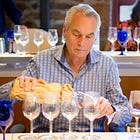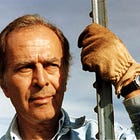NAPA VALLEY, Calif. — William E. Jarvis, who spent nearly a century building a life shaped by inquiry, discipline and deep attention, died July 16, surrounded by family and close friends. He was 99. Best known in Napa Valley as the founder of Jarvis Estate Winery and co-creator of the Jarvis Conservatory, he leaves behind a legacy measured less in headlines than in conviction — and in quiet, enduring influence.
He didn’t seek attention. But when he entered a room, people listened.
The first time I met him, in 2015, he and his son, Will, were leading a tour through the underground winery carved into the eastern hills above Napa.

The cave entrance — a pair of heavy doors set into the mountainside — opened into a world of stone, light and deep silence. Water echoed faintly as we moved deeper into passages lined with wine barrels and rooms that felt more discovered than built. A waterfall poured into the cave, forming a stream that wound alongside walkways and flowed beneath small bridges. Hidden chambers revealed displays of rare geologic forms — quartz, calcite, amethyst — while tasting rooms curved like underground chapels. The ceilings, arched high, held the cool breath of the earth.
Lights flickered gently against the walls. The farther we went, the quieter it became.
William didn’t speak often. But when he did, the words mattered.
He ran a hand along the cave wall — cool, solid, built to last.
“These caves will outlive us,” he said, his voice low. Then, after a long pause:
“But the name.”
He looked at his son, a small smile.
“Our name is on the bottle.”
That was the first time I felt the weight of who he was — not just what he’d done.

From Oklahoma to the Pacific
Born in Sayre, Oklahoma, in 1925, Jarvis came of age in a dry state during hard years. His curiosity — about machines, about people, about how the world worked — started early. After a stint at the University of Oklahoma, he entered the U.S. Naval Academy at Annapolis and served during the tense years after World War II.
After enrolling at UC Berkeley and then Stanford, where he pursued graduate coursework in electronics, philosophy and physics, Jarvis was recalled to active duty and served patrolling the waters off Korea during the war. When he returned, he completed his MBA. It wasn’t the credentials that mattered to him. It was the pursuit of understanding.
“If I found myself believing too quickly,” he said, “I’d study the opposite.”
In 1960, after a formative stint at Hewlett-Packard, he co-founded Wiltron — a Silicon Valley electronics company that helped shape the telecommunications field. He served as its president for 25 years.

From Circuits to Soil
In the early 1980s, Jarvis and his wife, Leticia — whom he met in Puebla, Mexico — began spending time in France. They studied literature at universities across the country and lived in a Louis XIV chateau. Later, they explored Spain, attending zarzuela performances and studying at Salamanca. They weren’t tourists. They were participants.
“We couldn’t decide between France or California,” he said.
It was Leticia’s memory of growing up on a hacienda that led them to the hills east of Napa. The landscape felt familiar. They stayed.
They purchased 1,320 acres and planted just 37.5 to vine. The rest, they left alone.
He didn’t build up. He built in.
The winery was constructed entirely underground — a vast, 45,000-square-foot solar-powered system of caves with fermentation tanks, labs, tasting rooms and a natural waterfall echoing in the deepest chamber. All wine production occurred below the surface.
He applied engineering principles to vineyard science. If older vines produced better wine, he asked, was it age — or canopy exposure? With guidance from Richard Smart, he proved that light exposure was of critical importance. He began leaf-pulling to improve fruit quality — a practice now used across the valley.

The Name on the Bottle
Will Jarvis grew up with this experimental quietude. At 13, he made his first wine in a dorm room as a science project. The family opened a bottle years later. “It had held up,” he said. “Fruity. Alive.”
Will returned home after earning an MBA from Stanford and working in finance. He now runs the estate with a steady hand — honoring tradition while adapting to changing conditions, including tighter water resources and a more volatile climate. He embraces technology but never as a replacement for touch.
“I wouldn’t change something that’s working,” he said. “Some things don’t need fixing.”
Beauty That Doesn’t Need to Be Sold
In 1995, the family opened the Jarvis Conservatory in downtown Napa. Inside a 100-year-old stone winery, they created a space for opera, dance and symphonic performance. Leticia introduced high-definition opera screenings and zarzuela festivals. The conservatory continues to host youth symphonies, Baroque dance and master classes.
“Wine is art,” William once said. “And art is how we stay connected to what’s most human in us.”
The conservatory wasn’t just another donation. It was a return — a way of offering something back that didn’t need to be bought or sold.

What Endures
William Jarvis believed in complexity but not complication. He trusted quiet. He avoided exaggeration. And he asked hard questions — of vines, of people, of himself.
He is survived by Leticia, his wife and partner in all things, and by their son, Will, who now carries the work forward — beneath the hills, among the vines and in the music that still echoes through the old stone walls.
That day in the caves, back in 2015, Will had repeated his father’s words —
“Our name is on the bottle.”
The two stood looking at one another until William smiled and nodded.
The silence said the rest.
Private services are being planned by the family.
Instead of gifts or flowers, please consider making a tax-deductible donation in his honor to the Jarvis Conservatory for the Arts.
--
Tim Carl is a Napa Valley-based photojournalist.




















